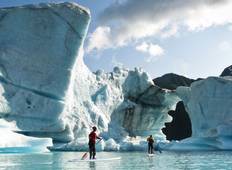

The late 19th century saw the discovery of gold in Canada’s nearby Yukon Territory, known as the Klondike Gold Rush, which brought a wave of prospectors to Alaska because of its transport links to the Yukon. As part of the greater missionary goals of the United States, the systematic eradication of indigenous languages, culture and arts was practised in Alaska – now a US territory – from the 1860s until the early 20th century. Indigenous Alaskans objected to the sale on the grounds that they had never given up the land to Russia in the first place, a fact that would become important in 20th-century legal stoushes. Russia ‘sold’ Alaska to the United States in 1867. Brutal treatment, murder and disease killed an estimated 50 per cent of the pre-Russian population, despite the fact that very few Russians actually settled in the area permanently. Fur was of particular interest to Russia, and Alaskan Native people were often enslaved and forced to collect otter pelts for Russian companies. Russian colonisation of Alaska began in the early 18th century in pursuit of natural resources and to spread the gospel of Orthodox Christianity. It’s generally understood that most of the land’s inhabitants were somewhat nomadic until about 5000 years ago when evidence suggests some groups began to build permanent settlements. Pre-colonialĪ detailed history of Alaska has been relatively difficult to uncover due to both the destructive nature of colonialism and the challenges the environment poses to researchers.


This theory assumes that Russia and North America were once connected by a land bridge until rising sea levels caused the land between them to submerge and become the Bering Strait. It’s believed that humans first arrived in the area between 12,000 and 15,000 years ago after travelling from what is now known as Russian Siberia. As rising temperatures change the landscape and affect animal migratory patterns, hunting and fishing have become more difficult. Climate change has proved particularly devastating for Alaska’s indigenous people and their traditional way of life.

While many indigenous Alaskans live in small rural communities, a growing number now live in urban areas like Anchorage. Alaska’s Native people consist of dozens of nations and tribes including Aleut, Inupiat and Yupik people. The main city of Anchorage has a small but passionate arts scene including the well-curated Anchorage Museum and a number of Native arts and crafts galleries.Īround 18 per cent of Alaska’s population is indigenous, of either Alaskan Native or American Indian descent. Nature-based hobbies like hiking, fishing and snow sports are all popular. When there are so few people in such a vast state, it makes sense to share resources and keep your friends close. The remote and wild environment fosters both a spirit of independence and a strong community. The harsh winter, connection to the Arctic Sea and permafrost means life in Alaska is not for the fainthearted. The culture of Alaska is indelibly shaped by the environment.


 0 kommentar(er)
0 kommentar(er)
